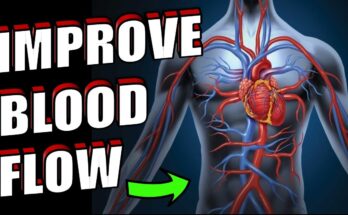Polymyalgia Rheumatica Treatment: Polymyalgia Rheumatica (PMR) is a chronic inflammatory disorder that predominantly affects older adults, causing significant pain and stiffness in the shoulders, neck, and hips.
The onset of PMR is usually rapid and symptoms can be severe, dramatically impacting the quality of life.
Understanding the nuances of diagnosis and the available treatment options is essential for managing this condition effectively.
Understanding Polymyalgia Rheumatica
Understanding the key aspects of this condition, including its symptoms, statistics on incidence and prevalence, and known risk factors, is crucial for early detection and effective management.
Key Symptoms of Polymyalgia Rheumatica
The symptoms of polymyalgia rheumatica can be sudden and disabling, impacting the quality of life significantly. Here are the most common symptoms:
- Muscle pain and stiffness: This discomfort is usually worse in the morning or after periods of inactivity, primarily affecting the neck, shoulders, and hips.
- Fatigue and general malaise: Many individuals experience a profound sense of tiredness and a general feeling of being unwell.
- Mild fever and anemia: These may occur alongside other symptoms, although they are less prominent.
- Loss of appetite and weight loss: Due to discomfort and systemic inflammation.
- Limited range of motion: Difficulty in performing daily activities that require arm and shoulder movement.
Statistics: Incidence and Prevalence Rates
Polymyalgia rheumatica is relatively common among the elderly:
- Incidence: Approximately 50 to 70 cases per 100,000 people over the age of 50 are diagnosed each year.
- Prevalence: It affects about 0.5% to 0.7% of the elderly population, with a slight predilection for women.
Risk Factors and Potential Triggers
While the exact cause of PMR is unknown, several factors have been associated with an increased risk of developing the condition:
- Age: The risk significantly increases in individuals over 50 years old, with the peak incidence in those aged 70 to 80.
- Genetic predisposition: A family history of PMR or related autoimmune conditions can raise the risk.
- Ethnic background: It is more prevalent among Caucasians, particularly those of Northern European descent.
- Environmental factors: Some studies suggest that outbreaks of PMR may be linked to certain viral infections, indicating a potential trigger by external pathogens.
However, prompt medical attention upon noticing symptoms is crucial, as early intervention can prevent complications and improve outcomes.
Diagnosis of Polymyalgia Rheumatica
Accurate diagnosis is crucial as it significantly affects the patient’s quality of life and can be associated with other serious conditions such as giant cell arteritis. Here, we discuss the clinical features, diagnostic criteria, and differential diagnoses necessary for the effective identification of PMR.
Clinical Features Commonly Observed in PMR Patients
Patients with Polymyalgia Rheumatica often present a range of symptoms that can be quite debilitating. Key clinical features include:
- Muscle Pain and Stiffness: Severe aching and stiffness in the neck, shoulders, upper arms, thighs, and hips. This stiffness is usually worse in the morning or after prolonged inactivity.
- Fatigue and Malaise: A general feeling of tiredness and lack of energy is frequently reported by patients.
- Low-grade Fever: Occasionally, patients may experience mild fevers.
- Loss of Appetite and Weight Loss: Some individuals may notice a decrease in appetite and unintended weight loss.
- Limited Range of Motion: Difficulty in moving affected joints, especially in the shoulders.
- Joint Swelling: Although less common, swelling in the joints or pain in the wrists and knees can occur.
Diagnostic Criteria for Polymyalgia Rheumatica
Diagnosing PMR involves a combination of clinical evaluation and laboratory testing, as there is no single test that can definitively diagnose the condition. The following criteria are commonly used:
- Age at Onset: Symptoms typically begin at the age of 50 years or older.
- Bilateral Shoulder Pain: Pain originating in both shoulders is a primary indicator.
- Morning Stiffness: Prolonged stiffness in the morning lasting more than 45 minutes.
- Elevated Acute Phase Reactants: Elevated levels of C-reactive protein (CRP) and erythrocyte sedimentation rate (ESR) are indicative of inflammation.
- Rapid Response to Corticosteroids: Symptoms often improve dramatically with low doses of corticosteroids, which is supportive of a PMR diagnosis.
Differential Diagnoses to Consider
Due to its nonspecific symptoms, several other conditions can mimic PMR and should be considered in the differential diagnosis:
- Rheumatoid Arthritis (RA): RA can cause similar joint pain and stiffness but usually involves smaller joints of the hands and feet.
- Giant Cell Arteritis (GCA): This is closely associated with PMR and can cause headaches, scalp tenderness, jaw claudication, and visual symptoms.
- Fibromyalgia: Characterized by widespread pain and fatigue, fibromyalgia lacks the inflammatory markers typical of PMR.
- Thyroid Disorders: Both hypothyroidism and hyperthyroidism can cause muscle weakness and joint pain.
- Other Myopathies: Conditions like statin-induced myopathy or inflammatory myopathies can mimic PMR symptoms.
However, diagnosing Polymyalgia Rheumatica requires careful consideration of the patient’s symptoms, age, and response to corticosteroids, alongside thorough testing to rule out other potential conditions.
Conventional Treatments for Polymyalgia Rheumatica
Here, we explore the most commonly prescribed treatments for PMR, with a special emphasis on corticosteroids, the first-line treatment option, as well as additional medications and therapies that can support symptom management.
Corticosteroids: First-Line Treatment Options
Corticosteroids are the cornerstone of treatment for polymyalgia rheumatica, offering quick relief from the symptoms of pain and stiffness. The most commonly used corticosteroid is prednisone, which is highly effective in reducing inflammation. Treatment usually starts with a higher dose to quickly control symptoms, followed by a gradual reduction in dosage to minimize side effects. The specific dosage and duration of treatment may vary based on the severity of symptoms and response to the medication.
- Prednisone: Typically, treatment begins with oral prednisone, with initial doses ranging from 10 to 20 mg per day, adjusted based on patient response and tolerance.
- Maintenance dose: After symptom control is achieved, the dose is gradually reduced to a lower maintenance dose, often between 2.5 and 5 mg per day, to balance effectiveness with potential side effects.
- Duration of treatment: Treatment duration can vary, but most patients may need to continue corticosteroids for a year or more. Regular monitoring and adjustments are essential to optimize therapy and prevent relapse.
Additional Medications and Therapies
While corticosteroids are effective, they are often supplemented with additional treatments to enhance efficacy, manage side effects, and address the needs of patients who may have contraindications to steroid use.
- Nonsteroidal Anti-Inflammatory Drugs (NSAIDs): For some patients, NSAIDs can be used to help manage pain and stiffness, although they are generally less effective than corticosteroids for controlling inflammation.
- Disease-Modifying Antirheumatic Drugs (DMARDs): In cases where patients have persistent symptoms or require long-term corticosteroid use, DMARDs such as methotrexate may be added to reduce steroid dosage and limit side effects.
- Physical therapy: To improve mobility and reduce discomfort, physical therapy can be beneficial. Tailored exercises help maintain muscle strength and joint flexibility, which are crucial for managing PMR.
- Regular monitoring and check-ups: Ongoing medical oversight is crucial, as adjustments in treatment may be necessary based on symptom progression and side effects.
By employing a combination of these conventional treatments, most individuals with polymyalgia rheumatica can manage their symptoms effectively and maintain a good quality of life.
Recent Advances in Polymyalgia Rheumatica Treatment
Understanding these advances is crucial for patients and healthcare providers aiming to manage symptoms effectively and improve quality of life.
Emerging Treatments and Therapies
The treatment paradigm for PMR is shifting beyond the traditional corticosteroids to include newer, more targeted options. These emerging treatments focus on minimizing long-term steroid use and its associated side effects. Some of the promising therapies include:
- Methotrexate: Used as a steroid-sparing agent, methotrexate can help reduce the total dose of corticosteroids needed, thereby diminishing the side effects.
- Tocilizumab: This interleukin-6 receptor antagonist, initially used for rheumatoid arthritis, has shown promising results in PMR patients, particularly those resistant to traditional steroid therapy.
- JAK inhibitors: A newer class of medication, Janus kinase inhibitors are currently under investigation for their effectiveness in treating PMR, offering a novel mechanism of action compared to existing treatments.
Research Studies and Clinical Trials Outcomes
Recent research studies and clinical trials have provided new insights into the management of PMR, guiding more effective and personalized treatment approaches:
- Tocilizumab Trials: Studies indicate that tocilizumab not only reduces symptoms more rapidly but also extends the duration of remission compared to conventional steroids.
- Steroid-Sparing Studies: Clinical trials focusing on steroid-sparing agents like methotrexate and azathioprine suggest these drugs can be effective in reducing steroid dosages and preventing relapses.
- Long-Term Outcomes Research: Ongoing research is examining the long-term outcomes of PMR treatment, emphasizing the need for therapies that maintain remission and manage symptoms without significant side effects.
The Role of Biologics in PMR Treatment
Biologics have revolutionized the treatment of various autoimmune and inflammatory diseases, and their role in PMR treatment is becoming increasingly significant. These medications, which include agents like tocilizumab, target specific parts of the immune system that drive inflammation, offering a more tailored therapy approach:
- Efficacy: Biologics have proven effective in reducing inflammation and providing symptom relief in PMR, particularly where traditional treatments have failed.
- Targeted Action: By specifically targeting inflammatory pathways, biologics reduce the systemic side effects associated with broad-acting corticosteroids.
- Quality of Life Improvements: Patients treated with biologics often report better quality of life due to more effective symptom control and fewer side effects.
As research continues to advance, the treatment of polymyalgia rheumatica is becoming more effective and patient-focused. These developments not only promise to improve patient outcomes but also offer a deeper understanding of the disease itself, paving the way for innovative treatments that could one day lead to a cure.
Lifestyle and Home Remedies for Polymyalgia Rheumatica
Living with polymyalgia rheumatica (PMR) can be challenging, but adopting certain lifestyle changes and home remedies can significantly alleviate symptoms and improve quality of life. Here are some effective strategies:
Dietary Recommendations and Nutritional Support
A well-balanced diet plays a crucial role in managing PMR symptoms. Here are some dietary tips:
- Anti-inflammatory Foods: Incorporate foods rich in omega-3 fatty acids such as fish (salmon, mackerel, and sardines), flaxseeds, and walnuts. These can help reduce inflammation.
- Antioxidant-Rich Foods: Fruits and vegetables like berries, oranges, spinach, and carrots are high in antioxidants, which combat inflammation.
- Whole Grains: Replace refined grains with whole grains like brown rice, oatmeal, and whole-wheat bread to maintain a healthy weight and reduce inflammation.
- Limit Processed Foods: Reduce intake of processed foods and sugars, which can exacerbate inflammation.
- Calcium and Vitamin D: Ensure adequate intake of calcium and vitamin D to support bone health, especially important as corticosteroids used in PMR treatment can weaken bones.
Physical Therapy and Exercises Tailored for PMR Patients
Physical activity is essential for PMR patients to maintain mobility and reduce discomfort. Here are some recommended exercises:
- Gentle Stretching: Helps maintain flexibility and reduce stiffness. Focus on gentle, flowing movements like those found in yoga or Tai Chi.
- Strength Training: Light weights or resistance bands can help maintain muscle strength and joint function, but it’s crucial to consult with a therapist to tailor exercises to your specific needs.
- Water Aerobics: Activities in a warm pool can be soothing for sore muscles and joints and also provide resistance training without the strain.
Stress Management Techniques and Their Benefits
Managing stress is key in controlling flare-ups of PMR. Here are some effective stress management techniques:
- Regular Exercise: Physical activity is not only good for your physical health but also boosts endorphins, which can help reduce stress.
- Meditation and Deep Breathing: These practices can help calm the mind and reduce anxiety, leading to lower levels of stress and inflammation.
- Adequate Sleep: Ensure 7-9 hours of quality sleep each night, as poor sleep can exacerbate symptoms.
- Social Support: Stay connected with friends and family or consider joining a support group for chronic illness to share experiences and coping strategies.
However, always consult healthcare providers before starting any new treatment or therapy to ensure it is safe and suitable for your specific condition.
Long-Term Management and Monitoring of Polymyalgia Rheumatica
Effective long-term management of Polymyalgia Rheumatica (PMR) is crucial for maintaining quality of life and minimizing the risk of relapses. This chronic inflammatory disorder can significantly impact daily activities, making ongoing monitoring and management essential. Here’s a closer look at the key components of long-term care for PMR.
Importance of Regular Follow-Ups and Monitoring
Regular follow-ups with healthcare providers are fundamental in managing PMR effectively. These check-ins help ensure that the prescribed treatment is working and allows for adjustments as needed. Monitoring may include blood tests to assess inflammation levels and discussions about any new or ongoing symptoms. Staying vigilant helps catch any changes in condition early, preventing complications and ensuring the treatment remains effective over time.
Managing Chronic Symptoms and Preventing Relapses
Chronic symptoms of PMR like pain, stiffness, and fatigue require continuous management. Adhering to a prescribed medication regimen is vital, as is lifestyle management involving regular exercise and a healthy diet. Recognizing early signs of relapse—such as returning symptoms or increased inflammation—enables prompt action, potentially involving adjustments in medication. This proactive approach helps maintain control over the condition and reduces the likelihood of severe relapses.
Patient Education and Support Groups
Educating patients about PMR is an integral part of management. Understanding the disease helps individuals recognize symptoms, understand treatment options, and know when to seek further medical advice. Support groups play a critical role by providing emotional support and practical advice from others who share similar experiences. These groups can be a valuable resource, offering encouragement and coping strategies that enhance the overall management of PMR.
Focusing on these aspects of care ensures that individuals with Polymyalgia Rheumatica can lead active and fulfilling lives despite their condition. Regular medical care, proactive symptom management, and strong support networks are all vital in the long-term management of PMR.
FAQs about Polymyalgia Rheumatica Treatment
What is the standard treatment for polymyalgia rheumatica?
The primary treatment for polymyalgia rheumatica (PMR) involves corticosteroids, such as prednisone, which help reduce inflammation and alleviate symptoms. Typically, a doctor will prescribe a low dose initially, adjusting it based on the patient’s response to the medication.
How long does treatment for PMR usually last?
Treatment duration can vary, but most patients with PMR need to continue their steroid regimen for about one to two years. However, the exact length of treatment depends on individual symptoms and how well the condition responds to steroids.
Are there any side effects of PMR treatment?
Yes, corticosteroid treatment can have side effects, including increased risk of infections, osteoporosis, high blood pressure, and weight gain. It’s important for patients to monitor for side effects and discuss any concerns with their healthcare provider.
Can lifestyle changes help manage PMR symptoms?
Incorporating lifestyle changes such as regular exercise, a healthy diet, and maintaining a healthy weight can complement medical treatment and help reduce symptoms. Physical therapy may also be recommended to improve mobility and muscle strength.
Is there a cure for PMR?
While there is no cure for PMR, symptoms can be effectively managed with steroids and other treatments. Most individuals experience significant improvement with proper treatment and can return to their normal activities.
When should I see a doctor for PMR symptoms?
If you experience symptoms of PMR, such as severe muscle pain and stiffness, particularly in the morning, it’s important to see a healthcare provider for a proper diagnosis and to begin treatment as soon as possible to prevent worsening of symptoms.
Conclusion
In summary, polymyalgia rheumatica (PMR) is a condition characterized by muscle pain and stiffness, primarily affecting older adults. Diagnosing PMR involves careful consideration of symptoms, blood tests indicating inflammation, and ruling out other conditions with similar manifestations. Treatment primarily involves corticosteroids, which effectively reduce symptoms but come with potential side effects. Regular monitoring and adjustments in medication are crucial to manage these effects and ensure optimal patient comfort and health.
Looking ahead, the future of PMR treatment is promising, with ongoing research focusing on understanding the underlying causes of the disease and developing more targeted therapies. Advances in genetic profiling and immunotherapy hold potential for more personalized and effective treatment strategies, reducing dependency on steroids and minimizing side effects. Continued research and clinical trials are essential to achieve these breakthroughs, offering hope for improved quality of life for those affected by polymyalgia rheumatica.
References
For additional reading and verification of the information discussed regarding Polymyalgia Rheumatica treatment, the following reputable sources are recommended:
- Mayo Clinic: Explore comprehensive insights on symptoms, causes, and treatments of Polymyalgia Rheumatica at the Mayo Clinic’s dedicated page here.
- Arthritis Foundation: The Arthritis Foundation offers detailed guidance on managing Polymyalgia Rheumatica, including medication options and lifestyle tips. Visit their page here.
- National Health Service (NHS): The NHS provides reliable information on Polymyalgia Rheumatica, its diagnosis, and ways to alleviate symptoms. Learn more by clicking here.
- WebMD: For an overview of Polymyalgia Rheumatica, including innovative treatment strategies and patient care tips, visit WebMD’s resource page here.
- American College of Rheumatology: Access detailed medical guidelines and research on Polymyalgia Rheumatica treatments from the American College of Rheumatology here.
Each of these sources provides valuable, scientifically-backed information that can help patients and healthcare providers alike in understanding and managing Polymyalgia Rheumatica effectively.



